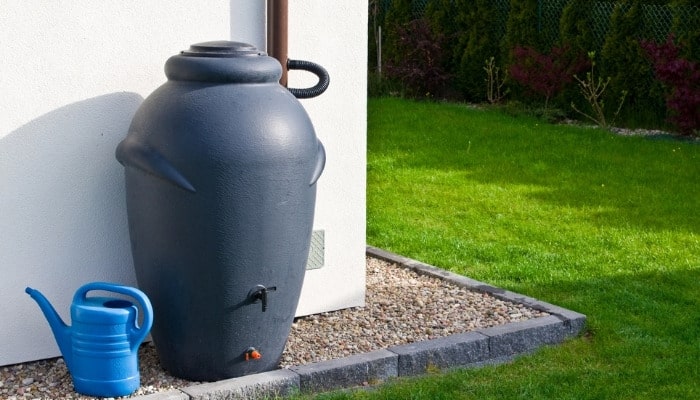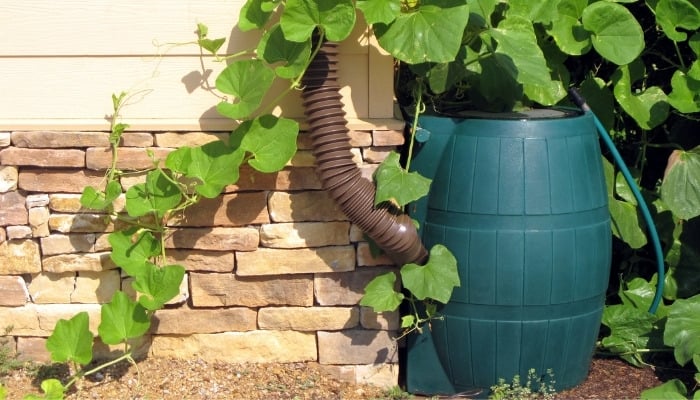Collecting and storing rainwater is one of the simplest sustainable gardening methods you can adopt. This involves both gathering and storing rainwater.
For most people, installing a rain-collection system is quick and easy, especially if they already have gutters on their homes.
How do you collect and store rainwater for plants? The most common way to collect rainwater for plants is to use gutters, a downspout, and a rain barrel to collect water from the roof during storms. The rainwater can then be stored right in the barrel for future use.
For most people, collecting and storing rainwater for their plants is a way to build a sustainable garden.
The cleaner water can help these gardeners grow healthier plants while they work to create a healthier planet.
Collecting & Storing Rainwater for Plants
Rain is the best source of water for your plants. By collecting and storing rainwater, you can extend the benefits long after the storms have passed.
Benefits of Storing Rainwater for Plants
- Free of chemicals, like chlorine and fluoride, that are used in the treatment of tap water
- Contains natural nitrates that help promote foliage growth
- Free source of water
- Higher oxygen levels than tap water
- Slightly acidic pH increases nutrient bioavailability in the soil
How To Collect Rainwater for Plants
Technically, any open container sitting outside during a storm can collect rainwater. This is an easy method if you just need a small amount of water for plants inside or on a patio.
Open-container rainwater will stagnate if not used quickly though.
For most people, collecting rainwater off the roof of their homes is the easiest method. You can also build catchment systems for larger operations.
To collect rainwater from your roof, you just need a gutter system, a downspout, and a container to hold the rainwater.
More advanced systems can include things like mesh covers on the gutters, permanent cisterns for collection, and a run-off collection tank.
When the rain falls onto your roof, it will run down the slope of the roof and collect in the gutters. The gutters will move the rain to a downspout.
Instead of the downspout directing water into the yard, it will attach to a collection barrel.
How To Store Rainwater for Plants
For home use, rain barrels are the most common collection container. Larger operations may consider installing an above-ground or below-ground concrete cistern.
Rainwater harvesting can be scaled to any size depending on the container chosen.
When storing rainwater, you want to make sure the container is as sealed as possible to prevent debris, pests, and polluted air from turning the water stagnant.
Using mesh coverings on the gutters and openings to the barrel can help keep the water clean as long as possible.
Where To Find Rain Barrels
The most affordable option for rain barrels is to find used containers from restaurants or businesses. This can be a riskier option because some of the larger barrels were used to hold chemicals.
You want to only use food-grade barrels that have never been used to store chemicals.
You can also buy barrels specially made for rainwater collection. They are available at local nurseries, garden centers, home improvement stores, and online retailers like Amazon.
This rain barrel is an excellent option for collecting rainwater for your plants.
DIY Rain Barrel
Almost any container can be turned into a rain barrel. The best material to use is non-clear plastic.
You could use an old trash can, a used food barrel from a restaurant, or a plastic drum used for non-harsh chemical products (like soap).
You’ll need to add an opening to the top for the downspout to attach to. It is also helpful to add an overflow exit on the side of the barrel a couple of inches from the top.
Finally, you can access the stored water by installing a spigot near the bottom of the container.
Long-Term Rainwater Storage for Plants – Things to Consider
While collecting rainwater is as easy as putting an open container out during a storm, there are a few considerations for long-term storage. The goal is to keep the water healthy and free of debris, pests, or pollution.
Things to consider when planning for long-term rainwater storage:
- Size of the storage containers
- Local regulations
- Length of storage
- Preventing debris and pests
- Water distribution
- Cleaning
- Room for bucket under the spigot
- Overflow
- Algae growth
How Long Can You Store Rainwater for Plants?
Typically, rainwater lasts 7 days without treatment. Over time, light, pests, and pollution can affect the quality of the water.
This contamination can actually reverse the benefits of rainwater and make it toxic for plants.
How To Keep Rainwater From Stagnating
To prevent your rainwater from stagnating, use it within a couple of days. Make sure that sunlight does not shine into your barrel. This will prevent algae growth.
Your collection and storage system should be as airtight as possible to prevent pests and pollution from affecting the quality of the water.
Some people opt to add a small amount of bleach to the water (1/8 teaspoon per gallon) and wait a day or so for the chlorine to dissipate before using it on their plants.

Avoiding Potential Problems When Storing Rainwater for Plants
There are easy solutions for common problems when planning your rainwater harvesting system. These accommodations will keep your system running smoothly.
Size of Storage Containers
It is important to get storage containers that make sense for the size of your roof/collection area and how much water you use per day.
A container too large can be expensive and unnecessary. A container too small will not hold enough water or cause you to waste overflow water.
Local Regulations
Check with your local municipality for any rules about rainwater collection. It is surprisingly illegal in some areas.
In many areas, there are regulations about who can collect rainwater on a given property, how the water can be used, if you need permits for installing the system, and more.
Length of Storage
In most cases, rainwater can be stored for up to a week without treatment. This usually isn’t an issue for personal gardens in areas with moderate rainfall.
If you live in an area where storms are infrequent, you may need to consider additional treatment options to keep the rainwater viable for longer periods.
Preventing Debris and Pests
The easiest way to prevent debris and pests is to cover any collection and transfer points with mesh.
Wider mesh can prevent larger debris from entering the gutters. Finer mesh on the downspout, barrel entrance points, and barrel exit points prevent both debris and pests from accessing the water.
By keeping your system as closed as possible, you can prevent pollution from making the water toxic.
By the same process that creates acid rain, polluted air can spoil rainwater in a storage container.
Water Distribution
For home setups, the rain barrel is usually located close to the house. This may not be the ideal location for using the water in your garden.
Installing a spigot on your rain barrel will allow you to fill water cans or attach a garden hose to your barrel. For a small rain barrel, you can also open the lid to fill watering cans when needed.
Cleaning
You should empty excess water from your rain barrel after it has been stored for approximately 7 days.
It is also recommended to regularly check your rain barrel for debris, pests, or algae. Using a container with a removable lid makes checking and cleaning easy.
At a minimum, you should do a full scrub of your container once a year. Do this cleaning at the end of summer because this period has the highest chance of algae and pests getting into your rainwater.
Overflow
During the rainy season (or year round if you live in a wet environment), you may not be able to use your rainwater as quickly as the barrel fills.
To prevent your downspout and gutters from backing up, make sure your rain barrel has an overflow spout. This is located on the size of the barrel a couple of inches from the top.
Your overflow can be just an opening or it can connect to a hose or pipe to direct the water somewhere in the garden.
Related Questions:
Is Rainwater Good for Indoor Plants?
Rainwater is excellent for all plants, but especially sensitive indoor plants.
Tap water can contain chemicals, minerals, and even pharmaceuticals that can wreak havoc on a sensitive tropical houseplant. Rainwater contains none or low concentrations of these things.
What Are the Disadvantages of Rain Barrels?
Some rain barrels are small in size. A half inch of rain can be enough to fill a small rain barrel and any excess is wasted.
The small size also means less water pressure if you are trying to use a hose to water your plants from the barrel.
Rain barrels also need to be located near the home or collection structure. Larger cisterns can use a series of pipes to transport water above or below ground.
Conclusion
Collecting and storing rainwater is a great way to make sure you always have clean and free water available for your plants.
Houseplants and garden plants alike will enjoy the benefits.

